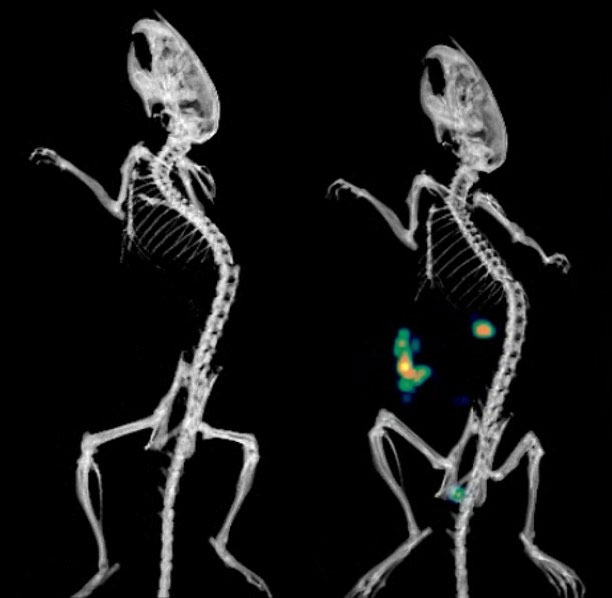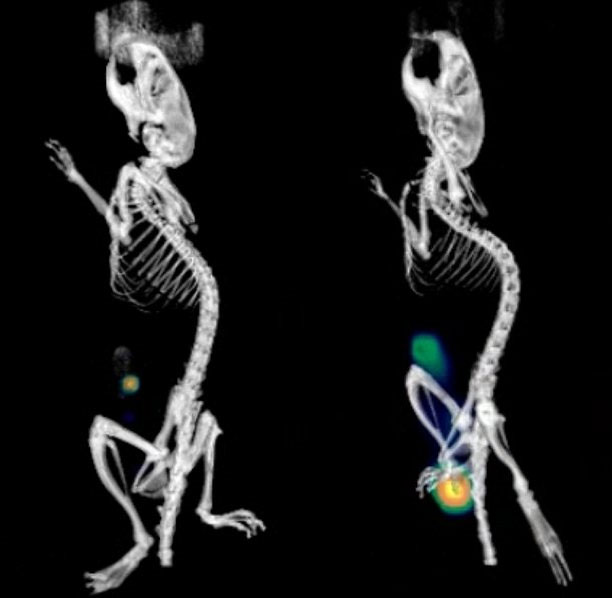Close-up of the life-and-death battle inside the body
For the first time in the world, British scientists have recorded real scenes about the fight against infection of the immune system in animals.
In experiments, the research team from Imperial College London implanted the bacterium 'Citrobacter rodentium' into a mouse, then monitored the ambush locations, the extent of the bacteria in the rat's body. until they are repelled by this rodent immune system. They found that the entire infection cycle took place over 12 days.

Mouse body before infection (left) and on day 1, when the scanner
clearly showed that Citrobacter rodentium bacteria in the small intestine. (Photo: Daily Mail)
According to the Daily Mail, because the 'Citrobacter rodentium' bacteria has been genetically modified to produce glowing ability, scientists can trace their tracks in the experimental mouse body with the new 3D scanning device. most advanced.
Each day, the team placed the mouse inside a living body scanner, which is a dark box with a sensitive bioluminescent camera at the top. They record the growth of bacteria by analyzing the amount of small light released from the animal's body. More light in any area means more bacteria gather in that area.

Day 4 (left), bacteria only appear in the cecum part of the intestine, but they are thought to be adjusting to adapt to the host body. By day 6 (right), bacteria open up the total attack and spread to the rectum. (Photo: Daily Mail)
Scientists closely monitored the body condition of the experimental mouse before being infected on day 0 until 11 days later. On day 1, after infection, they found bacteria concentrated mainly in the small intestine. From day 2 to day 4, they found that the number of intestinal bacteria increased, although they were still unable to enter a 'forbidden' area of the cecum (sac-sac).
On the 5th, the team only detected pathogens in the 'lymphoid capsule' in the cecum - an area that normally removes bacteria from the digestive system. 'We believe that this is where the pathogen (bacteria) adapts to the environment inside the host,' the scientists said.
However, on the 6th, the infection increased and spread from the cecum to the peripheral part of the rectum. By the 8th day, the whole intestine had been "occupied" by the dense bacteria.

On day 8 (left) the whole intestine was infected, but came on
9 (right), the immune system starts to react. (Photo: Daily Mail)
However, by the 9th day, the rat body began to promote the counterattack. The body's anti-foreign object reaction begins to clean up the infection in reverse order - first from the intestine and then to the cecum.
By the 12th, the battle was over and the scanner no longer detected any shadow of Citrobacter rodentium bacteria in the rat body. The rodent has successfully recovered, escaping from infection.

On day 10 (left) and day 11 (right), the process of infection declines. (Photo: Daily Mail)
Professor Frankel, who led the research, announced the work was "revolutionary" and could help scientists develop new strategies in fighting all kinds of infections, which often turn changed to multi-antibiotic resistant form.
Frankel added: 'The infection with Citrobacter rodentium in mice is a great model for studying human infection with E. coli 0157' . E. coli 0157 is currently a strain of bacteria that causes serious, sometimes fatal gastroenteritis. This bacterium is especially dangerous for children and the elderly.
- Research data on life after death
- 6 most bloody battles in the history of world war
- Life continues in the body 2 days after death
- The brain is still active 10 minutes after the body dies
- Detects traces of life after the body dies
- Human experience when it comes to death
- 10 things continue to happen on the body of the dead
- How does death feel?
- Found the 'smell of death'
- Close-up of cobra fighting with the eagle
- The mystery of life after death: There is no heaven, only infinite sadness and darkness
- People are still aware of being around after death
 Green tea cleans teeth better than mouthwash?
Green tea cleans teeth better than mouthwash? Death kiss: This is why you should not let anyone kiss your baby's lips
Death kiss: This is why you should not let anyone kiss your baby's lips What is salmonellosis?
What is salmonellosis? Caution should be exercised when using aloe vera through eating and drinking
Caution should be exercised when using aloe vera through eating and drinking